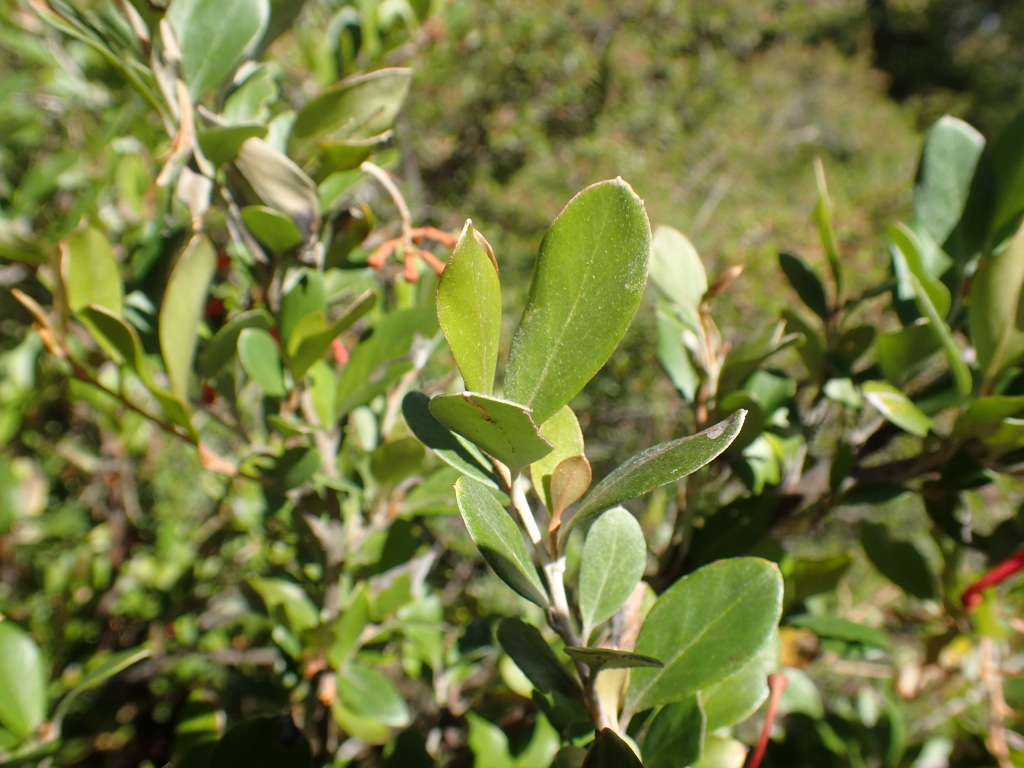Grevillea polychroma
(Molyneux & Stajsic) Molyneux & StajsicSpreading to erect shrub 1–3 m high, 1–5 wide. Branchlets densely subsericeous or subtomentose. Leaves entire, usually obovate, less often elliptic or narrowly elliptic, (12–)25-50(–80) mm long, (10–)33–70(6–)12–24(30.5) mm wide; leaf length to width ratio (2.0:1–)2.3:1–3.0:1(–4.3:1); upper surface glabrous, glossy, mid green; margins tightly and shortly recurved; lower surface moderately densely sericeous or subtomentose, epidermis usually obscured, lateral veins obscure or evident, reticulum absent or obscure. Conflorescences terminal, decurved to pendulous, simple to 3-branched, simple 69 %, 1-branched 26 %, 2-branched 4 %, 3-branched 1 %. Primary peduncles (0–)6–15(–21) mm long, 0.8–1.0 mm wide, indumentum densely subsericeous; floral rachises (11–)14–20 mm(–32) long. Limb of flower buds subglobose in side view, apex obtuse. Limb-segments of tepals (mature pre-anthesis flowers) not keeled or rarely obscurely keeled along external midline. Dorsal tepals (11.2–)17–20 mm long, 1–1.8(–2.0) mm wide. Perianth outer surface (below limb) with epidermis partially visible, densely subsericeous or subtomentose; inner surface glabrous except for beard near base; perianth inner surface creamish, pale yellow, pink, pinkish-red, or red. Pistil 19.2–21.5 mm long, ovary stipitate, glabrous, style creamish, pale yellow, orange, pinkish-red or red; face of pollen concurrent with style, usually flat. Fruits glabrous. Flowering mainly Jul.-Mar. In cultivation it can flower sporadically throughout the year.
EGU, HSF, HFE, VAlp. Grevillea polychroma is endemic to Victoria. Its distribution is centred mainly between Buchan and Gelantipy in East Gippsland.The eastern limit of its range being in the Brodribb Forest Block (Errinundra National Park), and the western extent being at Seldom Seen, near Dargo. Grevillea polychroma has a much broader altitudinal range and ecological amplitude than the similar G. brevifolia. It occurs between 80-940 metres above sea level. It is found in riparian sites, and open woodland to tall open forest.
Grevillea polychroma is very similar to G. brevifolia, from which it can be separated with the characters in the key.
 Spinning
SpinningStajsic, V.; Molyneux, W.M. (2006). Taxonomic studies in the Grevillea victoriae F.Muell. species complex (Proteaceae: Grevilleoideae) I. Descriptions of nine previously segregated, and three new taxa.. Muelleria 22: 22–76.
